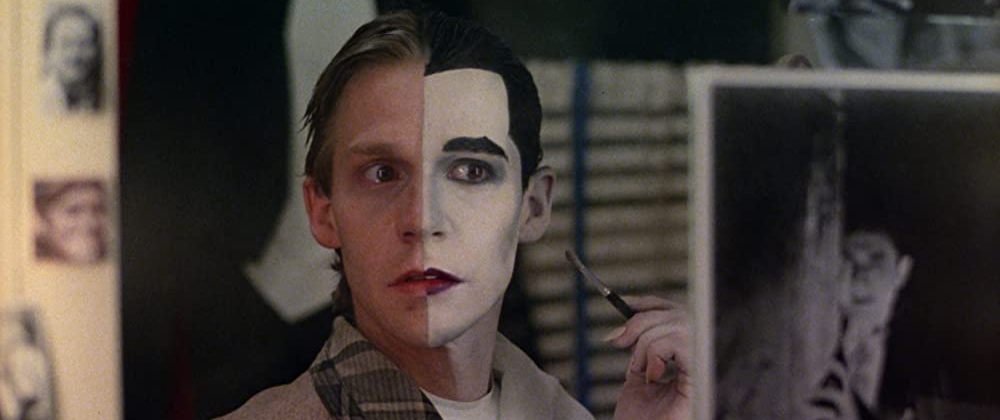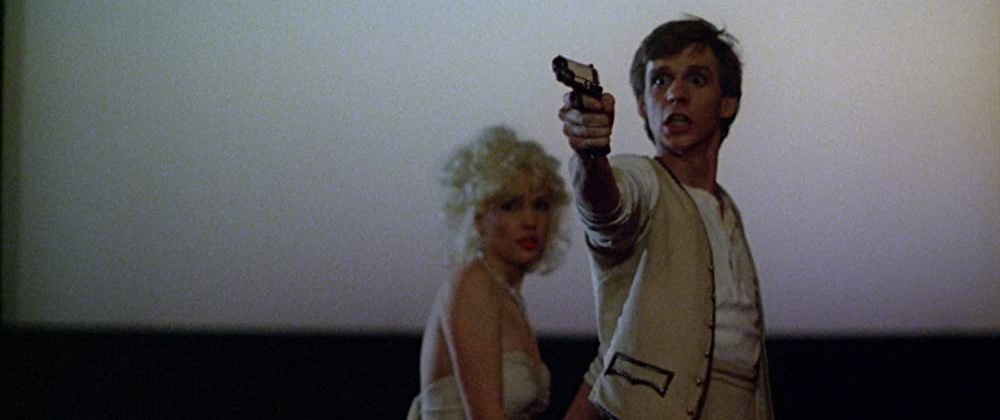FADE TO BLACK: Los Angeles And Lost Souls
One of the more unusual films to emerge from the American indie horror boom of the early '80s was Fade To Black. It had a clever marketing hook - a disturbed film fan dons different film-inspired costumes to kill those who have tormented him - and this no doubt helped in building the film's cult status. However, despite this hook and a decent-sized body count, it plays less like a shock-oriented thriller and more like a depressive character piece that explores the travails of living on the underside of Los Angeles' dream factory. Some of it doesn't really work but the parts that do have a disarming power and make it easy to see why it maintains a following.

The antihero of Fade To Black is Eric Binford (Dennis Christopher), a young man who spends every free minute he has watching films and immersing himself in Hollywood lore. His reasons for this lifestyle choice become readily apparent in the film's first act: he lives with shrewish, disapproving Aunt Stella (Eve Brent), who constantly berates him about his life choices, and is abused by boss and coworkers alike at his job. Isolated and bullied, he finds it easier to relate to films and his own cinematic fantasies.
A potential ray of light appears when he lucks into a date with friendly aspiring actress Marilyn (Linda Kerridge) but when that fizzles out for accidental reasons, he feels betrayed yet again. Aunt Stella finally pushes Eric too far and his fantasies curdle into real violence as he dons film-inspired costumes to kill those who have angered him. A progressive-minded police psychiatrist named Moriarty (Tim Thomerson) becomes the first to suspect Eric is the killer and tries to help - but Eric's ever-more-dangerous reign of terror means the cops might close in first.
It's easy to see the thriller potential in the above synopsis but Fade To Black never quite gets there for a few reasons. Writer/director Vernon Zimmerman has a fascinating main character in a Travis Bickle vein but the majority of the supporting characters are one-note ciphers, several designed to just be cannon fodder for Eric's psycho tendencies. The plotting is also lax, leading to meandering pacing and a battle between the commercial psycho-thriller plot elements and moments that are more like a depressive character study in a Curtis Harrington vein. Those two halves never quite gel, possibly due to the fact that Zimmerman left the film during editing and it was reshaped without his input.

The film also feels confused at the thematic level, suggesting that cinematic violence is destined to beget real-life violence: Eric's kills are frequently intercut with similar scenes from the movies that he's obsessed with and there's a memorably unsubtle scene where the zombies feasting on a corpse in Night Of The Living Dead are intercut with a repertory theater audience numbly munching their popcorn as Eric grooves on the carnage. This theme is given voice by the "hip" Moriarty character in a ludicrous pop psychology manner (of course, we also see him snorting coke and playing blues harmonica when no one else is around). This forced link between films and serial murder is as hollow as it is ham-handed in presentation - and more than a little hypocritical in a movie where such a reign of film-inspired terror is the selling point.
That said, Fade To Black also remains hypnotically watchable for a few key reasons. The prime one is a phenomenal, gutsy performance from Christopher in the lead. He took the film on the basis that he could embroider the characterization with his own touches and the result is a lived-in performance that communicates the character's mixture of bitterness, fragility and stifled rage with visceral intensity. As Eric's sanity slips and he devolves from an occasionally charming nerd to a detached predator, Christopher charts each phase in a fearless manner that evokes a complex response from the viewer.
The other key reason to watch Fade To Black is the convincing way it communicates the downside of life among the film buffs in Los Angeles. It portrays the city as a place full of predators large and small who are quick to exploit or taunt a misfit like Eric. As the film follows its antihero from repertory theater to film tourism sites to memorabilia shops, there's a palpable sourness to its portrayal of a setting where he lives right next to his fantasies without being able to achieve them. He's a major reason for his own problems but you also get the sense that he never had a chance in such a casually cruel setting full of malcontents, crooks and strivers.

Finally, it's worth noting that the film was made by people who love cinema despite the project's acidic take on life on the film business's underbelly. It's beautifully shot by Alex Phillips, Jr., a gifted cinematographer who worked on films as diverse as Bring Me The Head Of Alfredo Garcia and The Devil's Rain, and his work summons up a tremendous amount of seedy, downbeat L.A. atmosphere. The script is packed with references that film buffs will adore - everything from Samuel Fuller to Alfred Hitchcock to Phil Karlson - and the blurring between film and real life during the setpieces can be effective, particularly during moments that incorporate noir classics Kiss Of Death and White Heat. There's even a cool orchestrated rock score by Craig Safan that enhance the film's sometimes new-wavish vibe.
On a sidenote, cult film buffs will appreciate the support cast, which includes faves like lost new wave starlet Kerridge (lovable here) and Thomerson as well as familiar faces like Normann Burton and Morgan Paull, the latter doing fun work in brief scenes as a smarmy film producer. Best of all, you get one of the first performances by a young Mickey Rourke, who does a dry run for his early '80s success with his Method-style performance as a surly tough guy who takes out his frustrations on Binford at work.
In summation, Fade To Black fits into the designation of "flawed classic." It's thematically confused, ragged around the edges in structure/pacing and can't quite mesh together its different sides... but it has an indelible lead performance, setpieces that are conceptually unlike other horror films from the era and shapes up as a poison pen valentine to Los Angeles in a way that will reverberate with anyone who's lived on the fringes of the film business. If you're as besotted with cinema as its antihero, you may want to give it a look.

Blu-Ray Notes: after several years in home video limbo, Fade To Black finally made its high-def debut via a new blu-ray from Vinegar Syndrome. It boasts an excellent 4K transfer that shows off how strong the film's cinematography is and adds a barrage of special features, including a couple of commentary tracks and several interviews (including a great chat with Christopher).
https://youtu.be/-FKvQCd70AQ
https://youtu.be/B1_zFxeaICI


